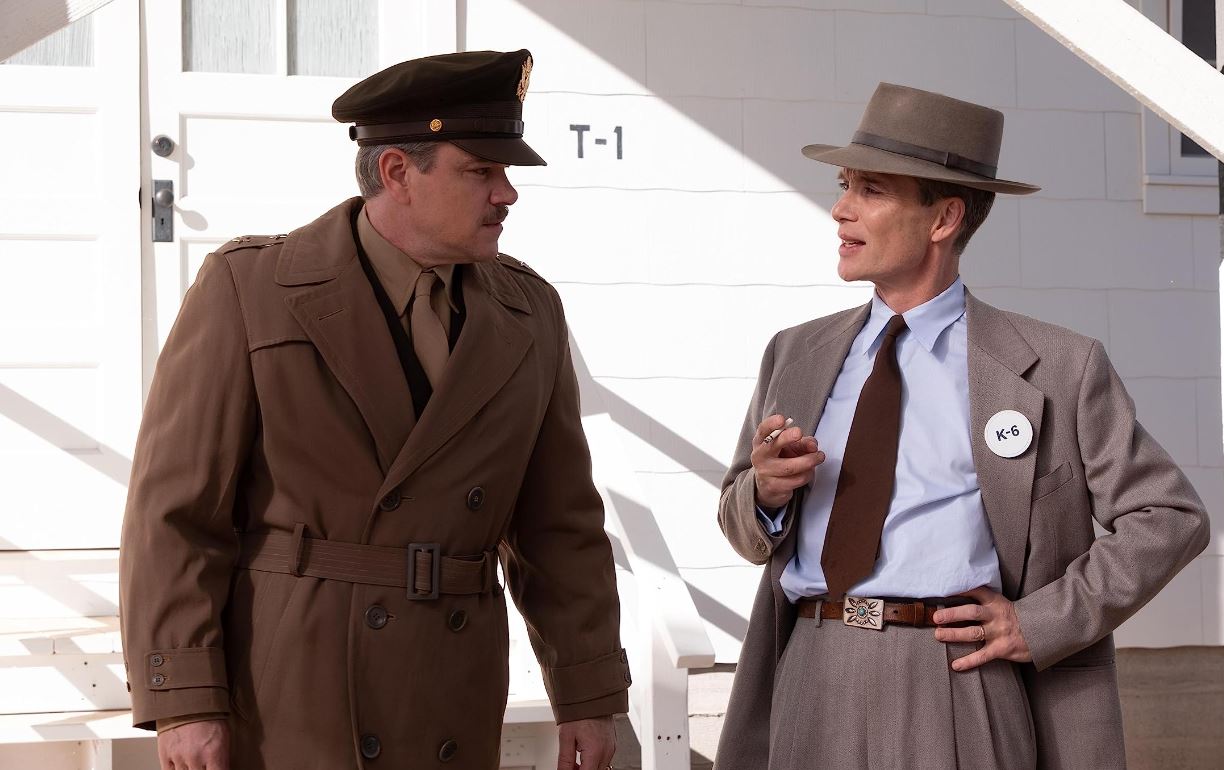| Worth seeing: | for the larger-than-life story of how the atom bomb was created, rather than the incidental back-room political hearings that have more to do with another character entirely |

| Director: | Christopher Nolan |
| Featuring: | Cillian Murphy, Emily Blunt, Jason Clarke, Josh Hartnett, Matt Damon, Robert Downey Jr, Alden Ehrenreich, Benny Safdie, Casey Affleck, Dane DeHaan, David Krumholtz, Dylan Arnold, Florence Pugh, Gary Oldman, James D'Arcy, James Remar, James Urbaniak, Kenneth Branagh, Macon Blair, Matthew Modine, Rami Malek, Tom Conti, Tony Goldwyn |
| Length: | 180 minutes |
| Certificate: | 15 |
| Country: | UK, US |
| Released: | 21st July 2023 |
WHAT’S IT ABOUT?
It’s less than ten years since the theoretical physicist J Robert Oppenheimer (Cillian Murphy) led the team that created the Atomic Bomb, assuring a US victory over Japan in the Second World War – but rather than being feted as a hero by his country, he’s now giving evidence to a hearing, at which officials are seeking to strip him of his security clearance.
Rumours of his communist leanings have been around for decades, but during the War, it was more important to have the right man to build the bomb.
Now, politicians – including the newly appointed Commerce Secretary Lewis Strauss (Robert Downey Jr) – are using his reputation to progress their own agendas – using his past to help their future; Strauss knows that undermining Oppenheimer will improve his chances of getting the US Senate to back him in his new cabinet job.
WHAT’S IT LIKE?
Christopher Nolan’s latest drama can be described as epic for a number of reasons – its three hour running time – its (largely) IMAX format – its subject matter (the creation of a bomb that could destroy mankind) – but ultimately, it falls short.
In typical Nolan style, it’s told through a fractured timeline – in this case, we follow Oppenheimer, his fellow scientists and the military men and politicians who’ve built their careers on the back of his work through no fewer than 6 time periods. In some films, this structure slowly reveals an unexpected bigger picture – but here, a less fractured timeline, with a few flashbacks, would have sufficed.
The main elements of the story include Oppenheimer’s student days, his early academic work, the development of the bomb and years later, the hearings to determine his security status and to confirm the cabinet appointment of his administrator, Lewis Strauss.
Nolan also uses a variety of filming techniques – including using the full IMAX screen and the smaller letter-boxed format, both in colour and in black-and-white.
The first task for the viewer is to decode the visuals – what do the various formats mean? Does colour represent the present and black-and-white the future? Is there a thematic significance to when it’s in IMAX or not? It’s not really clear – not least because there are some scenes – and timelines – which use both IMAX and letter-box and one that uses both black-and-white and colour.
Nolan his said he used different formats to denote subjectivity and objectivity but if that’s what’s going on, it’s not entirely clear.
And while this is billed as a biopic about the man who built the atom bomb, the narrative core of the film actually seems to revolve more around another character entirely, with flashbacks about Oppenheimer giving context and even feeling like they’re getting in the way of the real story.
Nolan presents us with a visual and intellectual puzzle, making us work hard to work out which storyline is happening when and how it relates to the others and there is a degree of satisfaction that comes from working out how things come together. But some of the revealing moments – or even twists – don’t substantially inform the wider story.
Whether it’s a film about the science behind the atom bomb, an expose of the machinations of the American political system, a study of the policing of thought or a combination of the above, what Einstein said to Oppenheimer at their first meeting might be historically interesting and contextually enlightening but it’s not narratively significant.
The film is unquestionably at its most interesting during the war years, as Oppenheimer, his fellow scientists and their military masters theorise, argue, design, build and test – and Oppenheimer’s internal and external experiences, writ large on IMAX make it a requirement to see this film on the biggest screen possible. But for much of the film, Oppenheimer as sitting at a table, talking to a handful of people in a room so small that people would have to stand up for you to be able to walk from one end to the next – and you don’t need IMAX for that.
Drawing the various strands together, Nolan has provided enough material for two impressive films – either of which could have provided background for the other if there was a budget for only one. But producing an unfocussed three-hour film that has its visual climax – what Nolan himself calls the “showstopper” – just two hours in feels like a wasted opportunity.
As you would expect from Nolan and his impressive all-star cast – Murphy, Damon, Downey Jr and Hartnett being among the most interesting to watch – there is an abundance of technically great film-making, but he hasn’t technically made a great film.
Although Damon’s General remarks that they’re working on “the most important thing to ever happen in the history of the world”, the film itself doesn’t feel important – it doesn’t feel like this is a piece of history that we didn’t know but really should. For a film centred on the creation of the atom bomb – arguably the most important thing to ever happen in the history of the world – it feels oddly inconsequential. Nolan might have felt this was a story worth telling because most people won’t have known what was going on in the wings, but the problem is, all that really matters, 75 years later, is what was happening on stage.
Nolan was clearly making this film to highlight what many regard as an historical injustice – interestingly, the White House undid that very historical injustice in December last year, but there’s no closing caption to reassure audiences – a consequence, perhaps, of a production taking so long to complete that when history changes, the film-makers either can’t keep up or don’t want to change their narrative thread.
The film – and the format – is at its best when we are following the science rather than the politics.
For a film named after the creator of the atom bomb, rather than feeling explosive, it rather fizzles out by the time the real protagonist’s fate is sealed.
